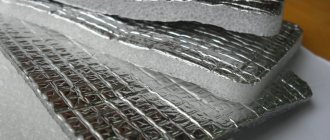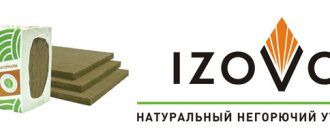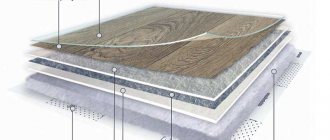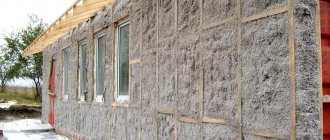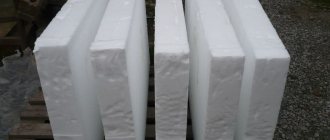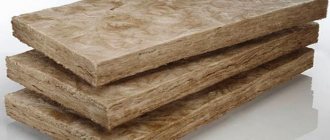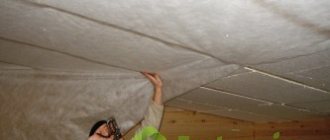What kind of thermal insulation material is this?
Let's start with definitions. The name "Penoizol" is a trademark of insulation created on the basis of urea resins. The material is in high demand, so it has become a household name, combining the following names:
- "Teploizol"
- "Mipora"
- "Unipor"
- "Mettemplast"
However, among professional builders, insulation is better known as liquid or poured foam.
In appearance, thermal insulation resembles marshmallows, which, after hardening, turns into an elastic mass that is guaranteed to fill all voids.
The composition of the insulation includes the following components:
- Urea resin
- Orthophosphoric acid
- Foaming additives
The ingredients are mixed in certain proportions and pumped into special cylinders where the mixture is under pressure.
Insulation of structures with foam insulation
When the spray device is ready and the solution is mixed, you can start working.
- As already mentioned, the first step is to install it according to the instructions or sequentially for a homemade device.
- A solution of liquid foam insulation raw material is poured into the container of the device.
- A sheathing is installed on the prepared surface (if thick layers of insulation are required).
- Insulation is applied to the working surface. Movements must be precise, the speed must be average. Do not spread the solution or apply very thick layers.
- When the layer is laid out, it is left for 2-3 days until it hardens completely, after which the excess is cut off with a knife.
Resin for penoizol is sold ready-made, already in solution, so it is better to use it than to measure the proportions yourself.
You should not lay out a thick layer of foam insulation between the walls, which will not be able to expand properly and will then shrink.
For thick layers, it is advisable to arrange the sheathing so that the foam evenly occupies the entire space allotted to it on all sides.
You can do professional foam installation work yourself, saving a significant amount of money.
What it is?
Penoizol is a modified polystyrene foam. Its consistency resembles marshmallow. The material is foamed plastic with a cellular structure. Modified polystyrene foam is a modern heat insulator for insulating building structures.
Often the material is prepared directly on the construction site. Using specialized equipment, the liquid mixture is used to fill voids in walls, ceilings, roofs and attics. Thanks to the production of insulation at a construction site, money, time and effort are saved on the delivery of conventional insulation and its loading and unloading operations. No additional space is required for storing thermal insulation products.
How to assemble a working installation
Buying a spraying installation for building a house is irrational. It’s much cheaper to rent it or assemble it yourself if you have:
- Gas-liquid installation;
- Compressor;
- Transport platform for containers.
The installation and the compressor are connected in series. The solution is poured into the container, the machine is started, and insulation layers are applied layer by layer, row by row, to walls, ceilings/floors or into molds.
If you have no experience in insulating with sprayed materials, you should seek help from professionals or test your strength on a separate area, for example, on an unnecessary board. It is important that the spray is uniform, without spitting. If necessary, adjust the solution supply power.
What is penoizol scientifically and where did it come from?
The Germans are considered the creators of penoizol. It was they who, in the thirties of the last (XX) century, synthesized urea with formaldehyde and obtained liquid foam. Today it is made and used differently than ninety years ago. The technology of its production at that time was so serious, complex and problematic that thermal insulation of houses and cottages with it was out of the question. Too expensive! Two decades later, the Germans conducted a series of studies and found that it could be obtained much easier. Reducing the cost of foam insulation has made it accessible to private homeowners.
In the mid-twentieth century, more precisely in the 50s, penoizol was already widely used in the thermal insulation of private houses and cottages in France, Austria, Germany, and even Japan. For residents of the Commonwealth of Soviet Socialist Republics or simply the USSR, it was inaccessible for a number of reasons. The price tag, cosmic for an ordinary person at that time, automatically endowed it with magical, miraculous characteristics. In addition, in the post-war country, penoizol was used in the aviation and rocket industries. It was impossible to get it even for those who lived, as they say, in abundance.
At the end of the era of Secretary General Brezhnev, the military began to use liquid foam. There is a version according to which penoizol was poured between the walls of strategically important objects for conspiracy. It was used to insulate cold armored weapons depots, metal hangars for fighter aircraft, workshops, factories, and service stations for special equipment. A factor in the rapidly growing popularity of penoizol was and remains the list of technical characteristics. One of the priority properties is unsurpassed fire resistance of class “G2”, as well as compliance with the interstate Russian standard “GOST 30244-94”.
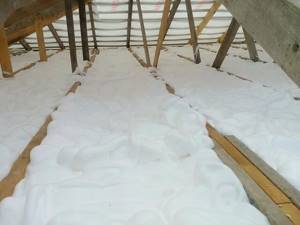
Insulation with penoizol
How to choose the required insulation option?
Modern technologies in the field of construction make it possible to carry out thermal insulation work in 2 ways:
- Outer;
- Interior.
Insulating the wall from the outside
Pros:
- All work is carried out outside the living space, thereby not reducing its usable area .
- Additional layers of vapor and waterproofing completely limit the access of moisture to wall structures, preventing the development of fungal infections.
- A wall insulated on the outside loses heat 6 times slower than one insulated on the inside.
- Thanks to the external thermal insulation layer, the load-bearing wall element warms up and remains warm on both sides. The zero temperature point is outside the wall .
- Thermal insulation also plays the role of a soundproofing cushion.
Minuses:
- Difficulty in installation . In addition, if the building is multi-story, then the help of industrial climbers will be required.
- During insulation, the appearance of the building facade will change.
- Installation work can only be carried out under certain weather conditions (no precipitation, air temperature above +5 degrees )
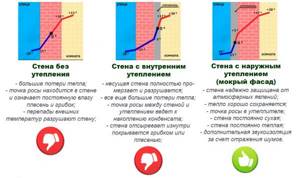
Comparison of insulation methods
Internal insulation of wall structures
Pros:
- Internal insulation work can be carried out at any time of the year .
- This option for insulating the room will be more economical, since all the work can be done independently.
- You can insulate a separate room , not the entire building.
Minuses:
- Reduces the internal area of the room.
- The wall elements do not warm up completely, which prevents them from accumulating heat.
- During operation, condensation may form between the wall and the thermal insulation layer . Dampness is an excellent environment for the development of mold and mildew.
- A layer of insulation will make it problematic to attach shelves and other hanging elements to the wall.
- Heat loss through wall structures remains at 10-15%.
Advantages and disadvantages
Foam compositions are positioned as the most effective means for insulating the walls of houses, as they have a lot of competitive advantages:
- high level of adhesion. The sprayed thermal insulation structure adheres well to the surface of the object being processed, regardless of the base material and configuration;
- efficiency. Liquid foam under pressure is able to penetrate into any cavities and fill cracks of varying complexity;
- low thermal conductivity coefficient. The presence of an air gap allows you to create a reliable barrier against heat leakage from the home;
- no seams. After polymerization, the foam insulation is a continuous sheet. Unlike other types of thermal insulation, the use of a sprayed product contributes to maximum reliability of protecting the structure from the formation of cold bridges;
- ease. The porous structure ensures extreme lightness of insulation, since 80% of the material is air in microcells;
- ease of installation. Before applying liquid foam to insulate the walls of a house, it is not necessary to prepare the base;
- fire safety. The material belongs to the category of highly flammable insulators;
- resistance to biological stress. The composition prevents the formation of fungi and mold.
Foam for insulation provides anti-corrosion protection in case of arrangement of wall surfaces with the presence of metal elements.
The disadvantages of foam thermal insulation include the following:
- the material reacts negatively to UV radiation and does not tolerate prolonged exposure to a humid environment;
- has a low coefficient of vapor permeability. It is required to install a forced ventilation system for the home;
- the bulk of current offers are sold in the expensive segment;
- To install effective foam thermal insulation options, the participation of specialists with professional equipment is necessary, which is reflected in the final cost of the work.
One of the key points noted is that installation work is carried out exclusively in protective clothing. Since toxic substances are released when spraying foam-air mass, it is necessary to work in special clothing, a respiratory mask and safety glasses.
Compound
In the production of penoizol, inexpensive components are used, due to which the finished material is affordable.
To produce this insulation you need:
- urea-formaldehyde resin;
- foaming component;
- orthophosphoric acid;
- water.
Dosed parts of these components are placed in special equipment (foam generator), to which compressed air is supplied. Through the use of such a device, a foamy mass is formed, intended for filling voids.
The modified foam is white in color and has a jelly structure. With its help, it is possible to quickly seal all air spaces. The applied foam hardens after 10 minutes. After 4 hours the mass becomes solid, and after 3 days it acquires “final” strength. 72 hours is enough for the material to dry completely.
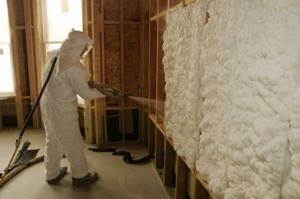
How to choose
When choosing equipment, you need to take into account many nuances:
- For the installation of liquid foam, two types of installations can be used - gas-liquid or pneumohydraulic equipment. The first, that is, budget-friendly, is suitable for insulating small-sized objects, for example, for a country house. pneumohydraulic equipment will differ in its enormous size, cost and performance. It is required to be chosen when it is necessary to perform large works.
- It is recommended to give preference to installations with a receiver and a built-in compressor.
- Pay attention to what the plunger pump is made of and its options. You should select a pump that is made of stainless steel/plastic. It must have a speed control function.
- You should not buy a unit with a foam generator attached to the pumping part.
We strongly advise against buying penoizol “blindly”. Be sure to ask sellers to make the material and demonstrate the qualities. The sample should be:
- Have a white color.
- Do not decrease in volume immediately after drying out of the installation sleeve.
- Withstand pressure with your hands after ¼ hour.
- Do not have heterogeneous or large pores.
- Recovers quickly after pressure.
If the manufactured mass meets all the requirements, you can safely buy it.
Price
One of the main advantages of the presented insulation is its price. Penoizol costs about 600 rubles/m³. At the same time, the quality of thermal insulation is not inferior to the popular insulation materials existing on the market today.

If we compare penoizol with mineral wool, a product with similar thermal conductivity will cost the consumer 1.5 times more. Moreover, the price of this insulation is 900-1000 rubles/m³.
The price of penoizol is 1.5 times lower than the cost of polystyrene foam. Material with similar thermal conductivity costs 950-1000 rubles/m³. The cost of extruded polystyrene foam is 6.6 times higher than that of penoplex. It is about 4 thousand rubles/m³ (taking into account the thermal conductivity coefficient).
Also, in terms of cost, urea foam is more profitable than basalt slabs, staple fiber and expanded clay. For this reason, many private property owners prefer this type of material.
Foam plastic or penoizol
According to customer reviews, penoizol is the most profitable and practical means for insulating rooms.
Penoizol is safer and has low thermal conductivity compared to polystyrene foam
The fact that knowledge and equipment is important for installing penoizol does not stop buyers, since its characteristics are better than those of foam plastic. If your budget is limited, you can buy polystyrene foam, since it is cheaper than penoizol, but it is better not to skimp on insulation
Technical characteristics of urea-formaldehyde foam (UFP)

It is believed that, in terms of its stated performance properties, penoizol is superior to any insulation available on the domestic market. The main characteristics of thermal insulation look like this:
- Thermal efficiency . The thermal conductivity of insulation varies between 0.031-0.041 W/m on the Kelvin scale. 10 cm layer of liquid foam to provide reliable insulation to the interior.
- Soundproofing . Penoizol absorbs up to 65% of street noise, which is considered a very good indicator.
- Fire safety . The material is not flammable and does not support combustion. However, when exposed to high temperatures, the insulation will simply evaporate without releasing toxic substances into the air.
- Dependence on chemical and biological factors . The insulation is neutral to any aggressive environment. In addition, the insulation is of no interest to rodents and is resistant to pathogenic microflora: fungus, mold.
- Moisture resistance . The material absorbs moisture well, but subsequently evaporates it without losing its original properties. Given this feature, it is recommended to install ventilation gaps to prevent the appearance of mold on the walls.
- Durability . Indicators of linear compression of insulation are 0.07-0.5 kg/cm2 . Accordingly, the material holds its shape well and quickly restores its structure.
Manufacturers claim that thermal insulation can last 30-50 years without loss of quality. However, insulation appeared on the market relatively recently, so there is no evidence of such an impressive service life yet.
DIY penoizol: home laboratory
Finding a liquid polymer for spraying is not as easy as we would like, so let’s consider a way to prepare a working solution yourself. What you need to prepare:
- Urea-formaldehyde resin;
- Foaming agent;
- Technical tap water;
- Orthophosphoric acid.
The ingredients can be purchased at a hardware store or chemical supply department. Please note that the components have a short shelf life (only a few months). To obtain normal working foam, you need to take only fresh raw materials. Otherwise, the insulation will be unstable, the layer will crack and shrink significantly.
The proportions of the components for making the solution, depending on the desired characteristics of the foam, may be different. If necessary, more resin and acid are used in dense foam insulation; accordingly, less material is taken for loose foam.
To prepare 1m3 of penoizol you will need:
- Resins 6...70 liters (more resin - denser foam). The material is heated to 20°C or more; there is no need to filter or control the viscosity;
- The water is heated to 20 degrees or more. You can use regular tap liquid. Its quantity is determined conditionally until the foam reaches the desired properties, the guideline is approximately the same volume as the resin;
- Foaming agent alkylbenzenesulfonic acid (ABSA) in an amount of 0.5...1.0% of the total volume after mixing the resin and water;
- The catalyst - orthophosphoric acid is taken in an amount of 0.2...0.5% of the total volume.
To produce penoizol brand M15, take:
- Resin = 20 kg;
- Water = 24.5 kg;
- Foaming agent = 0.1 kg;
- Acid = 0.4 kg.
- Additives to reduce cracking – resorcinol (50 g).
The components for penoizol are mixed and poured into the spray container.
Independent reviews from construction forums

To understand the real effectiveness of insulation, you should not unconditionally trust the words of sellers and manufacturers. It will be much more effective to turn to the reviews of real people who have already used the subject of our conversation for insulation. Let us immediately note that opinions on the properties of liquid thermal insulation are divided.
Not bad, but there was a small nuance. Alexander (www.forumhouse.ru)
Penoizol is an excellent alternative to any type of modern insulation. The price is quite reasonable, the mice will not be stolen, the declared characteristics are at a high level. However, during practical use, a small drawback emerged: when insulating wooden walls, unfilled areas remained.
Recommended by friends. The house has a comfortable microclimate. Ildar (mastergrad.com)
We decided to insulate the walls with foam insulation about 5 years ago: the outer wall is made of block and brick. 6-7 centimeters left between the masonry . Glass wool and mineral wool did not give the expected result: the wall began to mold, the rooms were quite cool.
Friends recommended penoizol. As the crew worked, one could hear and see the insulation filling the space between the walls, emerging from the cracks. Now the house maintains a comfortable microclimate at any time of the year.
No complaints, but problems arose during the filling process. Mikhail (forumnov.com)
It is clear that seamless insulation has undeniable advantages. There are no complaints about the quality of insulation, however, for the operation of the equipment, a connection to a 380 V . I did not have such an opportunity, which caused some difficulties during the pouring process.
I really don't like the toxic smell. Konstantin (forum.vashdom.ru)
After pouring, penoizol noticeably decreased in volume, which already reduces the quality of thermal insulation. In addition, the material has an unpleasant and clearly toxic odor. They said that the composition includes formaldehyde, the use of which has long been abandoned in European countries. I recently insulated the house, so I can’t say anything about the properties of the material, however, doubts about the correctness of the choice are already tormenting me.
The price of the work is steep. Eduard (www.forumhouse.ru)
Personally, I am satisfied that penoizol will not be chewed by mice, the insulation accurately fills any gaps, and provides reliable heat and sound insulation. I didn't like the fragility of the material and its susceptibility to deformation. And the overall price of the work is a bit steep.
Areas of application of penoizol
Due to the fact that penoizol does not increase its volume during hardening, it seems possible to use it in the following areas:
To fill the niches between the walls to ensure its supply, holes with a diameter of 32 mm are drilled in one of the walls in increments of about a meter. After the cavity is filled, the holes are sealed and, if necessary, the wall is finished.
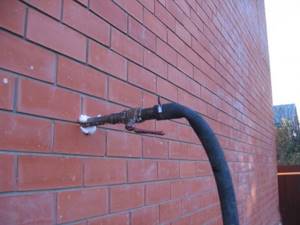
During the construction process, when using three-layer walls, for which filling is carried out not through holes, but from above, and it is possible to fill layer-by-layer to a height of up to three meters.
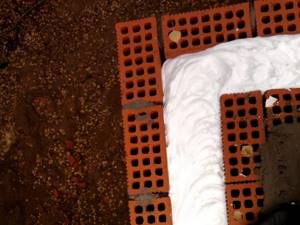
The possibility of insulating with penoizol not only the walls, but the gap between the siding and the wall, and the wall will not lose its vapor permeability property.
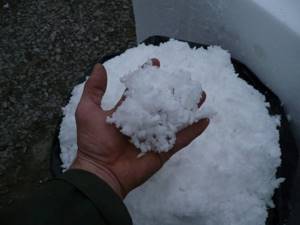
There are other uses for it, but in many cases the disadvantages outweigh the advantages.

Penoizol over time
6 years after insulating the house with foam insulation, the owners noticed dampness, mold and mildew on the façade of the extension. It turns out that the tiler, when laying the tiles in the shower area, did not provide waterproofing. The water gradually penetrated the partition until one day it came out.
Sasha decided to dismantle the siding that covered the façade and replace the rotten areas. When the siding and OSB panels were dismantled, everyone was shocked that the penoizol had shrunk by 50-60% . In fact, the insulation did not insulate anything.
It was necessary not only to redo the bathroom from the inside, but also to completely dismantle the external part of the extension in order to replace penoizol with mineral wool.
If you do not use insulation, then you will have to overpay many times over for heating or cooling your home.
Let me remind you that the more insulated the house, the less energy is needed to maintain the optimal temperature in it.
They say that the shrinkage of penoizol is only 1-3%, but Sasha saw with his own eyes that the shrinkage was 50-60%. If, when insulating mineral wool or expanded polystyrene, you can somehow control their installation, then how can you control the injection of penoizol? You can’t see it with your eyes and you can’t check it in any way.
The resins from which liquid foam is prepared have a limited shelf life. Who will guarantee that this deadline has not expired? It turns out that there seems to be good material for insulating a house, but it will not be possible to control the quality.
Look what Sasha says about penoizol insulation:
How much does foam insulation cost?
It took 12 cubic meters of penoizol to insulate the house and extension. Sasha paid 1,600 rubles for each cubic meter. But after 6 years I discovered that the house needed to be insulated again. For him, penoizol turned out to be a waste of time and money.
Filling the attic with foam insulation, liquid penop
The insulation of the attic depends on its purpose.
In the case of a cold, non-residential attic space, thermal insulation is applied to the ceiling. If the ceiling is wooden, a polymer film is fixed on top of the flooring over the entire surface, and when using reinforced concrete slabs it is laid only on the joint areas. Do-it-yourself insulation with penoizol is ensured by supplying a liquid mass from above and carefully leveling the surface. It is better to start leveling 12-16 minutes after pouring, when the mass becomes viscous. If it is important for the owner that the attic is warm, for example, to create additional living space in the house, then the roof is insulated with foam insulation. To do this, a film is first fixed on the roof rafter sheathing, and then in the space between the roofing material (slate, corrugated board, etc.)
d.) polystyrene foam is poured.
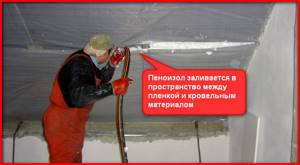
Harmfulness of penoizol and impact on human health
Get straight to the point! In the United States of America, as well as Canada, it was banned for use at the official state level for a long time. Later, researchers proved that during operation, liquid foam does not emit carcinogens and is therefore safe. As a result, the ban was lifted. Russian factories, which simultaneously act as suppliers, claim that this insulation is not inferior in safety to steak sawdust and ecowool. In England, the use of urea-formaldehyde insulator in the thermal insulation of residential buildings is permissible only with a special document in the form of permission from regulatory authorities.
Comparison of penoizol with other insulation materials
The fire resistance of penoizol is superior to foamed polyurethane. It does not ignite even with prolonged contact with open flame. This is facilitated by thermosetting resin, which, when interacting with flames, forms an infusible material. As for polyurethane foam, its flammability in classes “G1” and “G4” is determined by aluminum fire retardants. Upon contact with open areas, polyurethane foam is destroyed, loses its ability to withstand flames, melts and can ignite. In terms of service life, sprayed polyurethane foam is also inferior to liquid foam made from urea-formaldehyde ingredients.
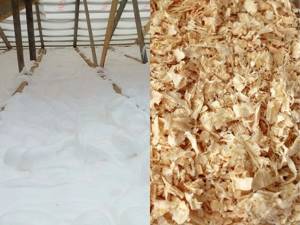
The most serious competitors of penoizol, in our opinion, are ecowool (dry cellulose) and crumbly sawdust steak. These environmentally friendly insulation products are the best on the market. They are made from wood fibers. They do not contain chemicals, except for antiseptics and fire retardants - products that are harmless to health. Meet international quality standards. They work better than any insulator, as they penetrate hard-to-reach points, crevices and depressions with a diameter of up to 0.01 millimeters. For objective reasons, they are officially approved for use in all countries of the world without any restrictions.
According to international statistics, in Europe, from 0.5 to 1.5 million residential houses, cottages and townhouses are insulated with ecowool. Americans use ecowool and sawdust every quarter to insulate 150,000 buildings and structures. As sad as it is to state, the “stupid” inhabitants of the notorious America, as Mr. Zadornov called them, have long been superior to us Russians in their knowledge of ecology. It is ecowool in the West that is considered the number 1 insulation material. Neither penoizol, nor polyurethane foam, much less basalt insulator, can compete with it. If you, as a reader, do not agree with this statement, please write your view of the situation in the comments to this article. Thank you!
Use in winter
Work in winter is difficult, as problems are created due to low air temperatures. This factor adversely affects the structural composition of penoizol. Approximately 50% of the resin consists of water. For this reason, the viscosity of the material increases. Despite all these unfavorable aspects, penoizol can be poured under certain conditions. Its components must be stored in a warm room at a temperature of at least +15°C, for example in a garage.
The installation must also be placed in a warm place. You can install the cheapest tourist tent for this. The materials must be compactly rolled up, covered with a layer of plastic film, and then the fan heater installed. Before starting work, it is necessary to heat the solution to +40°C, and the resin to +20°C. For this, a regular boiler is used.
More information about do-it-yourself penozol:
If all these rules are followed, you can get penoizol that is no different from the material installed under normal conditions. It is unacceptable to keep it at a temperature below +15°C, as it does not dry well. The moisture it contains will freeze. It will fulfill its role as a heat insulator only with the onset of spring. Moisture that does not freeze in the spring will evaporate by itself. Dry foam will remain unchanged.
Harmful or not?
According to numerous reviews online, most consumers of liquid foam complain about its toxic odor during installation and drying. As experts note, such situations are observed when purchasing a low-quality heat insulator. The fact is that some manufacturers, in order to save money, use cheap urea resin with numerous impurities.

A high-quality heat insulator may emit an unpleasant odor only during installation. This is explained by the fact that during polymerization the substance begins to release formaldehyde. However, their number is insignificant. In comparison, many modern paint products emit much more harmful substances, while penoizol manufactured according to standards ceases to emit formaldehyde even after drying.
Having compared all the pros and cons, we can conclude that it is better to refuse cheap insulation from unfamiliar manufacturers. It is better to overpay and give preference to well-known brands that have managed to win the trust of consumers.
Consumption rates for insulating material per 1m2
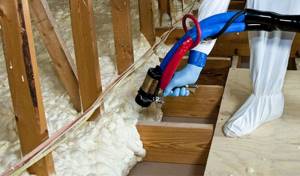
When planning a construction budget, you need to accurately determine the amount of material. To determine the amount of liquid insulation that will be required to insulate the entire building, you need to know the consumption rates of penoizol per square meter.
According to manufacturers, the consumption of liquid foam per 1 m2 varies between 1-1.3 liters.
To calculate the required amount of material, you need to multiply the length and width of the wall by the consumption rates stated by the manufacturer. For example: 7*3.2*1.3=29.12 l. In this case, the final amount of thermal insulation must be taken with a small margin, taking into account unforeseen situations.
Where is penoizol used?
Modified foam is used when pouring:
- spaces between OSB sheets and concrete floors;
- air gap between two load-bearing walls;
- inside the wall and external upholstery made of lining, siding or corrugated sheets;
- between the rafter system and the roof covering;
- in a frame assembled from false walls or partitions.
The composition and properties in demand in construction make it possible to widely use the new generation polymer. The overall qualities of liquid foam help in the construction of a wide variety of structures.
Accessories
To produce penoizol directly at the construction site and supply it, specialized equipment will be required. This includes gas-liquid installations, the function of which is to mix the components included in the material and supply the finished foam to molds or places of insulation. In addition to mixing units, you will need an air compressor and containers for reagents.
The operating principle of such an installation is simple: all containers with the necessary components and a compressor are connected to the gas-liquid unit via hoses. After mixing the reagents, foam forms. It is then fed into casting molds or air gaps at the construction site.
Before you buy penoizol, as well as purchase or rent all the necessary components for home insulation, it is important to familiarize yourself with some recommendations.
Brief instructions for installing penoizol
We work with the material according to the following scheme:
- We assemble the equipment according to the instructions.
- We mix all the components of the future penoizol in a container, based on the proportions specified in the instructions for the equipment.
- We prepare the surface by removing the remaining finishing materials.
- We make lathing or install logs from wooden beams in increments of 50 centimeters.
- Apply an even layer of foam to the surface so that it is flush with the edge of the sheathing or joists. We begin installation from the far end to the near end.
- Let the layer dry.
- After the penoizol has hardened, cut off its excess with a sharp knife.
- After complete polymerization of the material, we lay a reinforcing mesh.
- After this, you can begin plastering or painting the surface, if necessary.
[media=https://www.youtube.com/watch?v=T1WubwOFiIQ]
Positive reviews
Penoizol has already been used by thousands of domestic consumers. All people who installed this thermal insulation material noted that the room became much warmer. Because of this, energy consumption costs are reduced in the autumn-winter period. At the same time, a comfortable temperature and air humidity are established in the home.
Consumers noted both the quick installation of insulation and its low cost compared to other types of thermal insulation products. Using penoizol is an excellent way to reduce the cost of construction or reconstruction work without losing its quality.
For a comparison of the properties of penoizol and polystyrene foam, see the following video.
Insulation of house walls with liquid insulation - penoizol. in Moscow. Thermal imaging examination
The purpose of this article is to introduce you to a fairly little-known liquid insulation - penoizol (can also be called “Mipora”, “Unipor” or “Mettemplast”).
So, penoizol
Penoizol (also known as urea foam) is produced by foaming and subsequent polymerization of urea resin. The uniqueness of this technology is that the production process takes place directly at the insulation facility, where the product in liquid form and under pressure is supplied into the insulated cavities, allowing them to be completely filled with insulation. Saves effort, time, money on transport and loading and unloading operations. There is no need to take up space to store large volumes of insulation. There is no need to attach the insulation to the wall and related work.
The whole difference in the use of penoizol from conventional insulation is in the order of work. If soft roll and solid sheet insulation is attached to the wall and only then covered (protected) with a vapor-conducting membrane with a suspended facade or plaster, then for insulation with liquid foam insulation, a curtain façade is first built and only then liquid insulation is poured into the cavity under the vapor-conducting membrane.
Characteristics of urea foam
As an insulation material, penoizol can have a density of 10 - 30 kg/m3 and has remarkable thermal insulation properties with a thermal conductivity of 0.028-0.038 W/m² C. Compare, the thermal conductivity of classic polystyrene foam, depending on the density, varies in the range - 0.038 - 0.043 W/m ° WITH. Mineral wool boards with a density of 125 kg/m3 - 0.07 W/m² C (to prevent shrinkage of mineral wool during operation, a density of 120 kg/m3 and higher is recommended by manufacturers of mineral wool insulation for thermal insulation of vertical walls), and with a density of 200 kg/m3 - 0.08 W/m²C, i.e. penoizol as an insulation retains heat better than polystyrene foam and, in this parameter, is twice as good as mineral wool.
Urea foam, at one time, withstood a number of tests and was repeatedly studied in various laboratories in our country and abroad. State certification and licensing services Gosstandart, State Committee for SEN, Gosstroy, after detailed studies to ensure compliance with medical standards, certified urea foam plastic. In addition, penoizol was tested for fire resistance at the State Enterprise TsNIISK named after. Kucherenko.
The conducted studies confirmed the thermal conductivity coefficient in the range from 0.028 to 0.038 W/m² C.
The fire safety of penoizol is also quite high; the material corresponds to a flammability group not lower than G-2. Penoizol does not support combustion, which in itself is unique, given the organic basis of the material. When exposed to an open flame, penoizol gradually loses mass, charring and evaporating without the formation of melt drops, without emitting harmful gases or soot.
It tolerates significant cyclic changes in temperature and humidity well and without changes in its structure. At the same time, it has enviable durability. Laboratory studies gave an estimated service life of 60 – 80 years. At the same time, the Institute of Chemical Physics of the Russian Academy of Sciences, after studying penoizol for durability, wrote in conclusion that “the service life of penoizol is not limited.” This is confirmed by a study of samples of penoizol taken from walls insulated 60 - 70 years ago (the first experiments in using insulation). There were also no obvious signs of degradation.
The internal fine-mesh structure of the insulation effectively passes water vapor towards the lowest partial pressures. According to this indicator, penoizol corresponds to the best examples of insulation on the market. This characteristic classifies it as a “vapor-permeable” insulation material, which is a prerequisite for insulating the walls and ceilings of a house.
Application
The microcapillary internal structure of penoizol, which is highly permeable to water vapor, actively pumps moisture from the walls out through its volume, constantly drying them and preventing condensation from accumulating and the appearance of accompanying mold. Which is very valuable for any walls, especially wooden ones. A well-built and high-quality curtain wall with foam insulation as insulation guarantees a long life for a wooden house.
Like most insulation materials, penoizol is an excellent sound insulator. Its five to seven centimeter layer reduces mid-frequency airborne noise by three times, structural noise (transmitted through structural elements) by two.
Penoizol can be effectively used for insulation and sound insulation of walls, ceilings, floors and internal bulkheads of houses built from almost any modern structural materials. The efficiency, low cost and fire safety of penoizol made it attractive for insulating houses, as well as commercial and industrial buildings.
Penoizol is an effective, if not the only, material for repairing the heat-insulating layer of a building damaged during operation. The material can be used, for example, to fill cavities formed as a result of poor-quality installation or shrinkage of mineral wool, filling cavities formed from expanded polystyrene (foam) destroyed by rodents, voids formed as a result of shrinkage of bulk insulation - expanded clay, ecowool, etc.
Disadvantages of penoizol.
Like any other material, penoizol has advantages and disadvantages. In this article I will give the main ones:
- penoizol has a rather low mechanical tensile strength compared to extruded polystyrene foam and needs protection from mechanical influences.
- if water enters openly for a long time, it can accumulate a certain amount of moisture, which leads to a decrease in the thermal insulation properties of the insulation. But I note that, again, thanks to the capillary structure, it evaporates accumulated moisture very quickly.
— during the period of polymerization and drying, a small amount of formaldehyde gas is released along with water, but after 2-3 weeks, when the material gets rid of moisture, this indicator does not exceed the maximum permissible concentration.
— due to its hygroscopicity, penoizol cannot be used to insulate the underground part of foundations, and also cannot be used as insulation under reinforced concrete screed.
- in the case of pouring the material not into main walls (brick, concrete), but for example into a frame wall between two films, due to the impossibility of creating high pressure in the frame wall, penoizol has an unpleasant feature - shrinkage of the material during the drying process, which can reach 1%, in main walls, shrinkage is leveled out by the high pressure created in the wall during the pouring of penoizol.
To solve the problem of shrinkage of foam insulation in light frame buildings, Armoplast specialists developed a set of measures:
- technology for micro- and macro-reinforcement of penoizol using mineral additives and additional preparatory special measures, which allows you to completely get rid of the negative phenomena associated with shrinkage of the material in frame walls, ceilings, attics and guarantee reliable operation of the insulation throughout its entire service life
— rapid drying of the material is unacceptable, because penoizol during rapid drying does not have time to sufficiently polymerize and gain sufficient strength, which leads to a high percentage of material shrinkage (penoizol should be placed between the vapor barrier and windproof vapor-transparent membranes and dry for 2-4 weeks)
— mandatory use of the “correct” components, the so-called “foam-insulating” VPSG resin and Mettemplast technology.
Below are pictures taken using an electron microscope (magnification 500x - 600x) which show the structure of conventional and micro-reinforced foam insulation.
Photo 1 Photo 2
Photo 1 shows an opened empty capillary of a unit cell (“bubble”) of conventional non-reinforced penoizol; photo 2 shows capillaries of reinforced penoizol filled with mineral fillers, which helps combat shrinkage phenomena during drying of the material, and also gives additional strength and fire resistance to penoizol .
Thus, we see that penoizol has its own fairly wide area of application, and many of the above-mentioned disadvantages of the material can be eliminated technologically. Aenoizol must be protected from external mechanical and climatic influences (this requirement is the same for almost all modern insulation materials). Penoizol in frame house construction and open fills must be reinforced, which will eliminate shrinkage of the material and obtain an excellent monolithic seamless heat-insulating layer connected throughout the entire volume with reinforcing mineral fibers.
The effect of using penoizol to restore the thermal insulation of a brick house is perfectly demonstrated by a thermogram taken before (photo on the left) and after additional insulation was poured into the walls (photo on the right).
So, by choosing penoizol as the main insulation for the walls and ceilings of your home, you will receive an economical, reliable and durable material. A material that does not burn, “breathes” and does not harbor mice (a disadvantage of most modern insulation materials).
- penoizol is cheap, using it, you save at the construction stage, but you will get even greater savings during the heating operation of the house, since this insulation has one of the best characteristics in terms of thermal resistance. Penoizol is a combination of low price, good quality and high performance.
— since penoizol in its original form is liquid foam poured under pressure, free volumes in walls of any configuration are completely filled. This eliminates subsequent blowing and associated heat losses.
— the material has a low price, therefore, using it, you will have the opportunity to increase the insulation layer in the house without additional financial costs, thereby automatically laying the foundations for its future energy efficiency.
Based on the above, we can conclude: penoizol has both positive and negative properties. But for a specific, narrow use of the material - insulating walls, floors and ceilings of a house, the advantages outweigh its disadvantages. A good thermal resistance coefficient, durability, affordable price and excellent performance properties make it one of the best insulation materials on the market. Provided that the production technology of the material is followed, it can be recommended as insulation and sound insulator for walls, ceilings and partitions of almost any house and structure.


